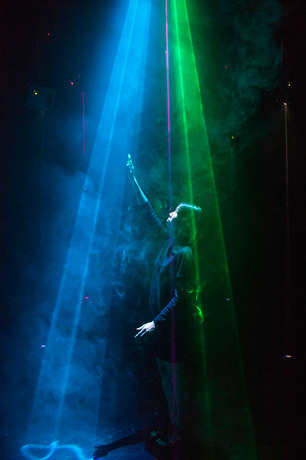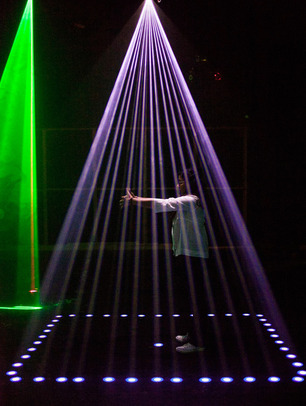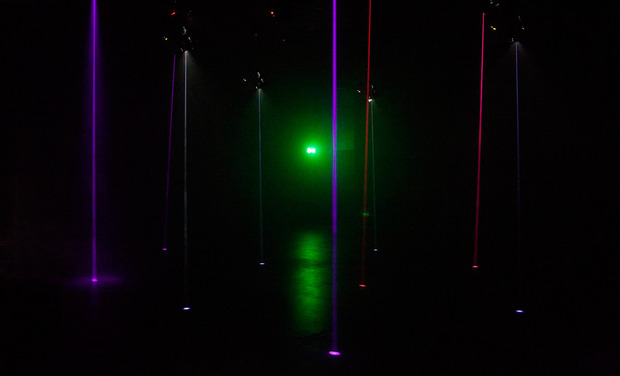Umbrellium’s Assemblance at Digital Revolution, London
A new, interactive installation in which teamwork reigns supreme


London’s cultural hotspot The Barbican is known for its visionary exhibitions, having hosted some of the city’s most exciting interactive art shows in the last few years, including Random International’s “Rain Room.” The locale continues its tradition of innovative art curatorship with new multimedia exhibition Digital Revolution, celebrating the transformation of the arts through digital technology since the 1970s.
The Barbican commissioned a number of artists to make new artworks for the exhibition, among them, Umbrellium; a local London collective best known for their mass participatory interactive outdoor events. Umbrellium has previously created pieces like “Burble,” in which the audience collectively constructed a gigantic, inflatable structure made of balloons that changed color in response to crowd interaction. Digital Revolution showcases Umbrellium’s first indoor artwork called “Assemblance” in the Pit—Barbican’s theater space, buried deep inside the Brutalist building.

Assemblance uses computer-controlled lasers to let visitors create beautiful, ever-changing light-sculptures and draw colorful patterns on the floor. The communal aspect of the work is integral to the experience. For example, by holding hands and expanding the light streams, groups of visitors can discover dreamy, psychedelic special effects that only appear intermittently—and only when people work together. The result is an immersive, captivating installation that perfectly shows how digital art can encourage physical interaction, bridging the gap between the audience and the artwork itself. It’s also a lot of fun, as you’re essentially creating something out of nothing. We recently spoke with Umbrellium founding partner Usman Haque about the project, audience participation and the future of digital art.


What was the idea behind “Assemblance”?
The basic idea is that people enter an environment filled with three-dimensional interactive light-structures they themselves have created, manipulated and modified. We’re using light to construct a semblance of physicality, and through sweeping gestures and gentle movements people leave trails of light behind and around them. They become players on a stage, collaborating with each other to build complex forms—or destroying them if they’re not careful. We’re interested in the structure of participation: how do you design an environment in which people that don’t know each other build up enough trust in each other to collaborate on building delicate, ephemeral, luminescent structures that could fall apart if treated too roughly.
Can you tell us a little about the technology behind the project?
In technical terms, we’re using quite standard equipment (haze, lasers, projectors, cameras and computers) but the software is custom-built; everything from the camera tracking to the laser control to the interactive audioscape. We also have custom-built equipment like air cannons, fabricated in our studio in Shoreditch London, to create targeted air movement and smoke rings. Our 3D printer has had to work round the clock to keep up!


How have people reacted to “Assemblance” so far—has the communal aspect been successful?
What’s interesting is the variety of unexpected interactions: people using their entire bodies, not just their hands to interact with the luminescent forms; collaborating by holding hands to generate novel structures; or pushing the light structures together. Some people recognize immediately that they need to treat delicate structures delicately; others start off thinking that if they move faster or wave their hands more widely they’ll have a greater effect—but they soon notice that careful, considered and deliberate movements have much more robust effects. There are also a number of “Easter eggs” (secret triggers that only come about if you do exactly the right thing at the right time, and you have to experiment to discover what that is), that people have already started uncovering. For example, creating an intimate luminescent pyramid full of bubbles.
How long does the most elusive Easter egg go on for—and how often will it appear? Can you give us a hint as to what it would take to discover it?
There is one ultra-special Easter egg that is only going to happen once in the entire span of the exhibition and it will last only about 15 seconds. It will require the collaboration between the entire group of visitors in attendance at the time.


Umbrellium is known for designing participatory interactive projects—what do you want to accomplish by creating interactive digital art?
Our intention here—drawing on our backgrounds in architecture and the design of networked urban infrastructure—is to explore how people relate to each other and to their surrounding environments and how they can create and collaborate on building their own environments and experiences. We put people’s perceptions, experiences and collaborations right at the centre of the project because (particularly in the context of technological developments that mean people can now have an effect on the other side of the world almost instantaneously—for good or bad) intimate and hyperlocal participation becomes even more important and the question of our responsibility, and our culpability, towards each other is thrown up in ways that it hasn’t been before. At Umbrellium we are working to develop new ways to work together, rather than against each other, and “Assemblance” is a particularly deliberate part of that process.

How do you think digital art will develop in the future?
To be perfectly frank I don’t really think about the “future” very much, and avoid predictions about where things might end up. We’re at a point in time when we can build quite a lot of the things we can imagine, and so it’s important for us to think far more carefully about the lyrical aspects and purposes of what we build. So, rather than speculating on what might happen some time down the road, I want to think about what we can actually do right now that will have a lasting and meaningful effect; how we can transform our environments, cities and human interrelationships *today* not some day later in life.
Umbrellium’s “Digital Revolution” is on display at London’s The Barbican now through 14 September 2014.
Images courtesy of Umbrellium












